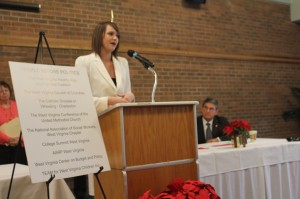
By Jen Wood Cunningham
Paying for college is a concern for many students but it doesn’t have to be a road block.
As 2013 begins, many students are thinking about graduation and beginning the next phase of their lives. These students, including many in our state, often wonder, “How will I pay for college?”
Scholarships are competitive and College Summit provides guidance to students in the program on how to advocate for themselves to receive financial support to attend college. In addition to applying for scholarships early and often, students are encouraged to complete the Free Application for Federal Student Aid (FAFSA) to determine eligibility for government grants and loans. Loans are helpful to supplement a financial aid package, but grants and scholarships are the most beneficial for students since they do not need to be repaid. Scholarships can be based upon merit, athletic ability, extracurricular activity, musical or artistic talent, ethnicity, geographic location, community service or leadership, while grants are based upon financial need.

Many students across the country rely on grant funds to pay for college. One of the grants received by many West Virginia students is the federal Pell Grant, which “provides need-based grants to low-income undergraduate and certain post-baccalaureate students to promote access to postsecondary education,” according to the U.S. Department of Education.
According to the U.S. Department of Education’s 2009-2010 Federal Pell Grant End-of-Year Report, 45,095 West Virginians received Pell Grants totaling $175,801,065 to pursue postsecondary education during the 2009-2010 academic year. Nearly 31,000 of those students were attending public colleges and universities.
College Summit alumni, current college students who graduated from the program in high school, spoke out at a recent community forum about the importance of the Pell Grant. Nikki Kinder, a student at Marshall University and an alumna of College Summit, shares, “I live by myself today. Pell Grants have kept me out of debt. It also inspired my mother, who is also in college now.”
Nicholas Alexander, a Valley High School and College Summit alumnus and a freshman at Marshall University states, “Without a college degree, it is vaguely a dream to achieve any great feat. So, that’s what the Pell Grant means to me. It is bringing life to my dreams. I am studying computer science and aspire to receive a doctorate and create the next piece of revolutionary software that will change the world, and without the Pell Grant, I would not stand a chance. Without the Pell Grant, I may not be able to complete my degree due to lack of funding.”
This program helps Nicholas, Nikki and many more students across the country pursue a college education every year. At the end of 2012, there were concerns that the funding for the Pell Grant could be cut because of the current budget crisis. Those concerns will most likely be warranted considering the Pell Grant and other educational programs were on the federal chopping block during the recent fiscal cliff discussions. As quoted in New York Times Online, Mark Kantrowitz, founder of Finaid.org, warned readers of “across-the-board spending cuts” that would result in “an 8.2 percent reduction in student aid funding.” Kantrowitz also shared that “fewer students will be able to get work-study jobs and Federal Supplemental Educational Opportunity Grants, as these programs would experience cuts. Fees for federal education loans would go up and the maximum Pell Grant would be cut by as much as $400.”
With cuts in grant funding and students and families feeling more pressure to find ways to pay for college, it’s more important than ever for students to begin planning early. Maintaining or improving grades, completing scholarship searches and applications, applying for the FAFSA and preparing for graduation makes the senior year very hectic. There is much to do and many worries looming overhead, but if students have a plan and take action, they can achieve their goal of graduation and pursuing college. College Summit’s curricula for grades nine through 12, educator training, administrator support, data tracking and hands-on activities for students in the partner schools help everyone stay focused on activities and goals for each grade level to ensure success for the students and the school.
About the Author
 Jen Wood Cunningham is a born and raised West Virginian, a first generation college graduate and a college access advocate. For nearly a decade, Wood Cunningham has promoted education and community development for nonprofit organizations and higher education institutions. As the community relations manager for College Summit, she connects volunteers, alumni and high school students with opportunities to grow and learn. Woods Cunningham graduated from West Virginia University Institute of Technology in 2001 with a bachelor’s degree in business management and from West Virginia University in December 2009 with a master’s degree in integrated marketing communications. She currently serves on the Golden Bear Alumni Association Board and is a proud member of Leadership West Virginia. She can be found on LinkedIn at http://lnkd.in/G45KxG or on Twitter @collegesummitwv or @miss_sociable.
Jen Wood Cunningham is a born and raised West Virginian, a first generation college graduate and a college access advocate. For nearly a decade, Wood Cunningham has promoted education and community development for nonprofit organizations and higher education institutions. As the community relations manager for College Summit, she connects volunteers, alumni and high school students with opportunities to grow and learn. Woods Cunningham graduated from West Virginia University Institute of Technology in 2001 with a bachelor’s degree in business management and from West Virginia University in December 2009 with a master’s degree in integrated marketing communications. She currently serves on the Golden Bear Alumni Association Board and is a proud member of Leadership West Virginia. She can be found on LinkedIn at http://lnkd.in/G45KxG or on Twitter @collegesummitwv or @miss_sociable.









One Response
How can I get scholarship from college summit because i was part of the college summit programm